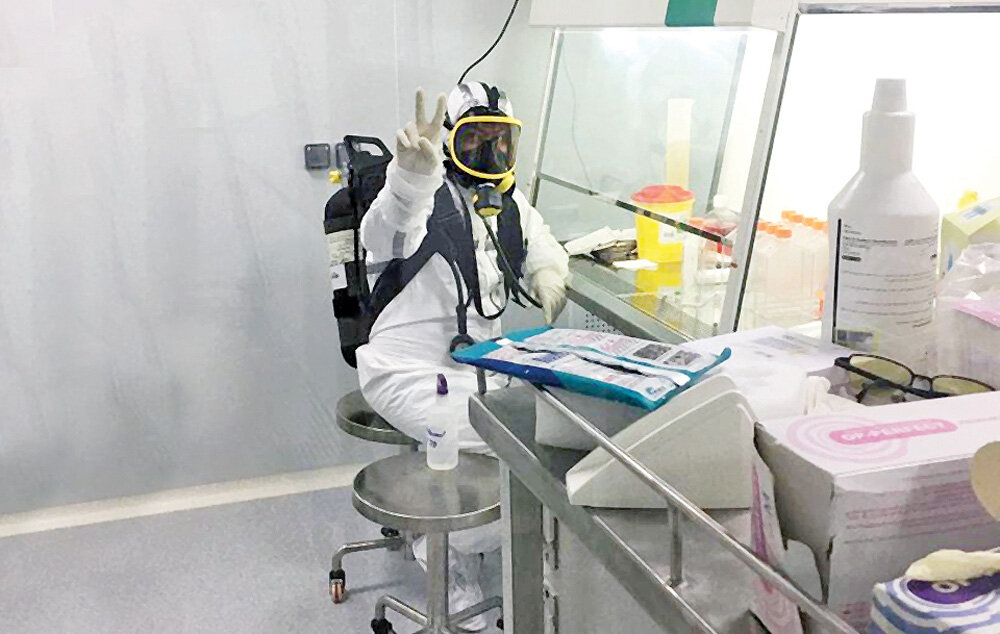High hopes for COVID-19 vaccine in Iran

TEHRAN – The latest achievements of Iranian researchers for developing COVID-19 vaccine platforms were discussed in a meeting on Tuesday in the presence of Health Minister Saeed Namaki and senior representatives of the World Health Organization.
On the sidelines of the meeting, the health minister said Iran will soon be recognized as one of the leading countries in coronavirus vaccine development.
Vaccine platform in several Iranian companies, including in the pharmaceutical department of the Headquarters for Executing the Order of the Imam, has successfully passed the first and second phases and are going through the third phase, he explained.
The procedure of vaccine testing before final approval is divided into five steps: Stage 1, Phase I, II & III, and Stage 2.
“We were all surprised to hear the scientific achievements of Iranian researchers,” said Ahmad al-Manzari, the regional director of the World Health Organization.
Various methods are taken to develop the vaccine in several countries around the world, but one of the methods that are being followed in Iran is completely new and unique, and we hope that the researchers, using stem cell and cell therapy, to achieve ultimate success, he added.
“We are pleased with the scientific and pharmaceutical advances in Iran, and the fact is that in Iran all methods and platforms are used to make the vaccine which shows that political restrictions have no effect on scientific development,” Christoph Hamelmann, WHO Representative in Iran said.
Widespread vaccination by Sept. 2021
Mostafa Ghane'ei, an official with the Vice Presidency for Science and Technology, said that the domestically produced COVID-19 vaccine will probably be injected into the whole population in the [next Iranian calendar year] month of Mehr (starting September 23, 2021).
Emphasizing that no Iranian vaccine has been yet allowed to enter the human phase so far, he said that “progress is made when the Food and Drug Administration issues a vaccine clinical work permit.”
All vaccines are in the pre-clinical stage and it is hoped that at least 4 vaccines to start phase 3 of the human trial in September 2021, he highlighted.
Now that coronavirus vaccines have been developed in the world and the third phase of clinical trials has passed, the possible side effects are almost certain, and Iran will be aware of the side effects which speeds up the process, he noted, adding, “vaccines produced in Iran are the same as those produced in China, India, the United States, etc.”
Iraj Harirchi, the deputy minister of health, has said that in Iran, 12 groups are making efforts to develop coronavirus vaccine, three of which have passed the animal testing.
Last week, Namaki expressed hope that the country will introduce the home-grown COVID-19 vaccine by the end of the current Iranian calendar year (March 19, 2021).
Vaccine testing procedure
Before human trials testing the coronavirus, the vaccine began with injection into mice or monkeys to see how they respond. After animal tests turned out well, researchers enlisted volunteers for a Phase I trial.
Scientists give the vaccine to a small number of people to test safety and dosage as well as to confirm that it stimulates the immune system.
In this phase, the volunteers are kept under observation to watch for negative reactions and to see whether they make antibodies against a pathogen. If Phase I trials go without serious safety problems, a larger group of hundreds of people are registered for Phase II testing.
Scientists give the vaccine to hundreds of people split into two groups, such as children and the elderly, to see if the vaccine acts differently in them.
The goals of Phase II tests are to study the candidate vaccine’s safety, immunology, proposed doses, schedule of immunization, and method of delivery.
Successful Phase II candidate vaccines move to larger and longer trials in Phase III, involving thousands of people. Phase III goal is to assess vaccine safety in a large group as certain side effects might not surface in smaller groups tested in earlier phases. To detect a significant difference for a low-frequency event related to candidates, the trial would have to include 60,000 subjects.
Vaccine efficacy is tested as well as other factors include: 1) Does the candidate vaccine-preventable disease? 2) Does it prevent infection with the pathogen? 3) Does it lead to the production of antibodies or other types of immune responses related to the pathogen?
After successful Phase III trials, the vaccine developer will submit an application for a license for mass production. Then the regulating body will inspect the facilities to review the manufacturer’s tests of lots of vaccines for potency.
All participants in the trials must be voluntary and normally receive monetary compensation, but it tends not to be particularly generous. All data from the testing must be made public so government agencies and other scientists can evaluate it.
COVID-19 taking high toll
In a press briefing on Wednesday, Health Ministry spokesperson Sima-Sadat Lari confirmed 13,421 new cases of COVID-19 infection, raising the total number of infections to 801,894. She added that 576,983 patients have so far recovered, but 5,712 still remain in critical conditions of the disease.
During the past 24 hours, coronavirus daily deaths and new cases hit the record high, as 480 patients have lost their lives, bringing the total number of deaths to 42,941, she added.
Lari noted that so far 5,626,631 COVID-19 tests have been conducted across the country. She said the high-risk “red” zones include provinces of Tehran, Isfahan, Qom, East Azarbaijan, South Khorasan, Semnan, Qazvin, Lorestan, Ardebil, Khuzestan, Kermanshah, Kohgiluyeh-Boyerahmad, Gilan, Bushehr, Zanjan, Ilam, Khorasan Razavi, Mazandaran, Chaharmahal-Bakhtiari, Alborz, West Azarbaijan, Markazi, Kerman, North Khorasan, Hamedan, Yazd, and Kordestan.
The provinces of Hormozgan, Fars, and Golestan and Sistan-Baluchestan are also on alert.
FB/MG
Leave a Comment